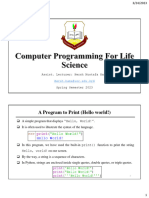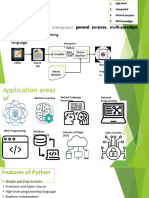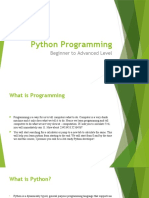Python Unit - 1
Uploaded by
SATHISHKUMARPython Unit - 1
Uploaded by
SATHISHKUMARUNIT – 1 ORIGINS
Python – origins – features – variable and assignment –Python Development
basics – statement and syntax – Identifiers –Basic style guidelines – Developed by Guido van Rossum.
Python objects – Standard types and other built-in types – Internal Developed in 1980’s.
types – Standard type operators – Standard type - Built-in functions. Python 0.90
First version
PYTHON BASICS Released in Feb, 1991
It was created by Guido van Rossum Support class. Inheritance, exception, functions & modules
Released in 1991 Python 1.0
Case Sensitive Released in Jan, 1994.
High-level language. Support map & filer etc.
Interpreted. Python 2.x
Object-oriented. Released in Oct, 2000.
Open source. Support more features than previous.
Cross-Platform. Python 3.x
FEATURES Released in Dec, 2008.
Build websites. It is also known as 3000 or Py3K.
Software Development. Python 3.5+
New release called Release Cycle with a Long-term Support
Machine Learning.
(LTS).
Artificial Intelligence.
Developed in 2015.
Data Science.
Python 3.8 and beyond
Automate tasks.
Released in Oct, 2019.
Analyze data.
Included many features.
Python 3.9 & 3.10 Continued with additional features.
V. Naresh Kumar, M.C.A., M.Phil., Page 1
PYTHON BASICS Playground section
Create an object of the class.(naresh)
Simple Example Program:
# Sample Python program.
import math
s = int(input("enter the value:"))
print (math.sqrt(s))
Output:
Enter the value: 25
5
Documentation section:
Mention the program name.
Optional.
Import statements
Includes various in-built or user-defined modules.
Global declaration section
Variable that we can access from anywhere in the program
Class section
Information about the user-defined classes.
Subprogram section
Set of statements that will execute.
V. Naresh Kumar, M.C.A., M.Phil., Page 2
STATEMENT 2. Multi-Line Statements
The source code executed by the Python interpreter is called (\n) used for the next line.
a statement. But, also separated by continuation character (\).
The Python has different types of statements like, Example:
1. Assignment Statements Program
2. Conditional Statements
3. Looping Statements, Etc.,
1. Single Line Statements:
# used for comment.
Separated by semicolons (;)
Output
Example:
Program
Output
V. Naresh Kumar, M.C.A., M.Phil., Page 3
IDENTIFIERS VARIABLE AND ASSIGNMENT
Naming the variable, class and function. Variables
Rules for Naming an Identifier Variables can be defined as containers.
Identifiers cannot be a keyword. Rules for Variable declaring
Identifiers are case-sensitive. Cannot be a keyword.
It can have a sequence of letters and digits. ... Start with an alphabetic (Or) Underscore.
Start an identifier with a letter (Or) Underscore. Whitespaces are not allowed.
Whitespaces are not allowed. We cannot use special symbols like !, @, #, $, and so on.
We cannot use special symbols like !, @, #, $, and so on. Variable Assignments
Example: There are two types of variable assignments,
1. Single value assignment:
Variables that store only one data value.
Example:
2. Multiple Value Assignment:
Variables that store more than one data value.
V. Naresh Kumar, M.C.A., M.Phil., Page 4
BASIC STYLE GUIDELINES 5. Using docstrings
1. Use a tab for indentation Used in functions and classes.
Use a tab for indentation Use the triple quotes.
This makes code more readable for multiple functions and Example:
method. def sample():
Example """This is a function"""
def sample(random): """
# statement 1 This
# statement 2 is
# ... a function
return random """
2. ASCII encoding class Sample:
Using Pythons' default ASCII encoding is the best practice """This is a class"""
for international environments. """
3. Comma in tuples This
It's not mandatory is
Example a class
tup = (1, 2, 3,) """
4. Using spaces 6. Comment Updating
It's best to use a space before and after an operator. Don't forget to update the comments while updating code.
Use a space after the comma is more readability. It's one of the most important things in coding.
Example 7. Character that shouldn't be used as variable names singly
import random Characters that shouldn't be used as variable names lonely.
result = random.randint(1, 3) + random.randint(1, 2) 8. Don't use ASCII characters in identifiers
Using ASCII characters in identifiers is not at all a good
practice.
V. Naresh Kumar, M.C.A., M.Phil., Page 5
STANDARD TYPES ii) float
This contains real numbers.
Example:
b = 40.5
print("The type of b", type(b))
2. Sequence Type
Python supports three kinds of Sequence type,
o String
o List
o Tuple
String:
1. Numeric Quotation marks can be used to describe the string.
Values are stored in numbers. A string can be defined using
o Single.
type() - determine the types of variables.
o Double (Or) Triple quotes.
Python supports three kinds of numerical data.
Example:
o int
str = "string using double quotes"
o float
print(str)
o complex
List
i) int
List is like arrays in C.
This contains Whole number
But, here it contains data of different types.
Example:
a=5 It encased square bracket [].
print("The type of a", type(a)) Example:
str = ["string using double quotes"]
print(str)
V. Naresh Kumar, M.C.A., M.Phil., Page 6
Tuple OTHER BUILT-IN TYPES:
Tuples is like list. 1. Binary Types:
This also contains data of different types. Bytes: Immutable sequence of bytes.
It encased brackets ( ). Byte array: Mutable sequence of bytes.
Example: 2. Numeric Types:
str = ("string using double quotes") Decimal: Represents fixed-point and floating-point
print(str) arithmetic.
3. Dictionary Fraction: Represents rational numbers.
A dictionary is a key-value pair set. 3. Iterator Types:
Elements are arranged in any order. Iter: Returns an iterator object for an iterable.
Curly braces { } are used to separate the items. 4. Generator Types:
Example: Generator: Represents a generator function.
str = {"string using double quotes"} 5. Text Type:
print(str) str: Besides being a standard type, it's worth mentioning as it
4. Boolean has various methods for text manipulation.
True and false are the two default values. 6. File Types:
False can be represented by the 0 or the letter "F,". File: Represents a file object.
True can be represented by any value that is not zero. 7. Module Types:
5. Set Module: Represents a module.
The data types are in unordered. 8. Function Types:
Example: Function: Represents a function.
num = {1, 2, 3} 9. Code Types:
Code: Represents compiled Python code.
10. Type Types:
Type: Represents the type of an object.
V. Naresh Kumar, M.C.A., M.Phil., Page 7
INTERNAL TYPES 6. dict:
Internal types are fundamental to Python and are used to Represents a dictionary, an unordered collection of key-value
represent and manipulate data. pairs.
1. int: Example:
Represents integer values. my_dict = {'name': 'John', 'age': 30}
Example: 7. set:
x = 42 Represents an unordered collection of unique elements.
2. float: Example:
Represents floating-point (decimal) values. my_set = {1, 2, 3, 4}
Example: 8. bool:
y = 3.14 Represents boolean values, either True or False.
3. str: Example:
Represents strings (sequences of characters). flag = True
Example: 9. NoneType:
s = "Hello, World!" Represents the absence of a value.
4. list: Example:
Represents ordered, mutable sequences. my_variable = None
Example: 10. Complex:
my_list = [1, 2, 3, 4] Represents complex numbers.
5. tuple: Example:
Represents ordered, immutable sequences. complex_num = 3 + 4j
Example:
my_tuple = (1, 2, 3, 4)
V. Naresh Kumar, M.C.A., M.Phil., Page 8
BUILT –IN FUNCTION 6. Logical Operations:
1. Type Conversion: bool():
Convert between different data types. Convert a value to a Boolean.
int(), float(), str(), list(), tuple(), set(), dict() any(), all():
2. Math Functions: Check if any or all elements in an iterable are true.
Perform mathematical operations. 7. File Operations:
abs(), pow(), round(), max(), min() Perform file operations.
3. Input / Output: open(), read(), write(), close():
print(): 8. Object-Oriented Programming:
Print to the console. Check object types and class relationships.
input(): isinstance(), issubclass():
Read input from the user. 9. Functional Programming:
4. String Manipulation: Perform functional programming operations.
len(): map(), filter(), reduce():
Get the length of a string or collection. 10. Exception Handling:
str(), ord(), chr() Handle exceptions or Error.
Convert between strings and Unicode characters. try, except, finally:
format(): 11. Time and Date:
Format strings. Work with time and date.
5. List, Tuple, Set, and Dictionary Operations: time(), datetime(), strftime()
sorted(), reversed():
Return sorted or reversed versions of a sequence.
sum(), max(), min():
Calculate the sum, maximum, or minimum of a sequence.
V. Naresh Kumar, M.C.A., M.Phil., Page 9
STANDARD TYPE OPERATORS 2. isinstance()
1. type() Check if a variable is of a certain type.
Determines the type of an object. function takes two arguments.
Example:
Additionally, for comparing types, the == operator can be
used.
V. Naresh Kumar, M.C.A., M.Phil., Page 10
PYTHON OBJECTS Inheritance:
Class: The classes inherit the attributes and methods from another
It is a user-defined data type. class.
Defines a blueprint for creating objects. The class inherited from is parent class.
It encapsulates data and the methods. The class inherits is called the child class.
The parent class is also called base class.
The child class is also called derived class
Example:
Object:
An object is an instance of a class.
It is created from the class.
Attributes:
Attributes are data members.
Hold information about the object.
Defined within the class.
Methods:
Methods are functions.
Defined within a class. ------------------------------------- END -------------------------------------
Perform operations on the object's data.
V. Naresh Kumar, M.C.A., M.Phil., Page 11
You might also like
- A Powerpoint Presentation On Python: by Durga Prasad KopanathiNo ratings yetA Powerpoint Presentation On Python: by Durga Prasad Kopanathi33 pages
- Python Notes Second Semester BVOC Computer ApplicationNo ratings yetPython Notes Second Semester BVOC Computer Application27 pages
- Isom 3400 - Python For Business Analytics 2. Python Basics: Yingpeng Robin ZhuNo ratings yetIsom 3400 - Python For Business Analytics 2. Python Basics: Yingpeng Robin Zhu55 pages
- Class XII - L1 - Python Revision Tour 1No ratings yetClass XII - L1 - Python Revision Tour 118 pages
- Object Oriented Programming Using Python: Name:Ankeet Giri Reg No.: 11904096No ratings yetObject Oriented Programming Using Python: Name:Ankeet Giri Reg No.: 1190409620 pages
- Python GTU Study Material E-Notes Unit-1 12012021081509AM100% (1)Python GTU Study Material E-Notes Unit-1 12012021081509AM29 pages
- _Basic guide of Python Programming Language_No ratings yet_Basic guide of Python Programming Language_36 pages
- Pushkar 6 Weeks Industrial Training ReportNo ratings yetPushkar 6 Weeks Industrial Training Report82 pages
- Unit 1 Introduction on to Python Programming LanguageNo ratings yetUnit 1 Introduction on to Python Programming Language16 pages
- Career Hackers: Hack Your Career Today Python in Finance100% (1)Career Hackers: Hack Your Career Today Python in Finance26 pages
- Mastering Python Programming: A Comprehensive Guide: The IT CollectionFrom EverandMastering Python Programming: A Comprehensive Guide: The IT Collection5/5 (1)
- (Ebook) Control Systems: Principles and Design by M. Gopal ISBN 9780070668799, 0070668795 instant download100% (1)(Ebook) Control Systems: Principles and Design by M. Gopal ISBN 9780070668799, 0070668795 instant download47 pages
- 1 - Overview of JavaScript, Advantages of JS, Difference Between Java and JSNo ratings yet1 - Overview of JavaScript, Advantages of JS, Difference Between Java and JS52 pages
- TRICYCLE Fare Matrix For One (1) To Two (2) PassengersNo ratings yetTRICYCLE Fare Matrix For One (1) To Two (2) Passengers2 pages
- 10 Best Data Annotation & Labeling Service Providers in 2024No ratings yet10 Best Data Annotation & Labeling Service Providers in 202418 pages
- Optimization_of_GND_Contact_Placements_for_Cavity_Resonance_SuppressionNo ratings yetOptimization_of_GND_Contact_Placements_for_Cavity_Resonance_Suppression4 pages
- Carestream Health - Worldwide Procurement Contact List: Role Director Worldwide PurchasingNo ratings yetCarestream Health - Worldwide Procurement Contact List: Role Director Worldwide Purchasing1 page
- GCOE Amravati - Placement Report AY 2019-20No ratings yetGCOE Amravati - Placement Report AY 2019-203 pages
- Arch.G5 RSCH Technological Advancements Final PaperNo ratings yetArch.G5 RSCH Technological Advancements Final Paper56 pages
- Cold Room Calculator: Mobile App For iOS & AndroidNo ratings yetCold Room Calculator: Mobile App For iOS & Android2 pages
- Create A Centralized and Decentralized Organizational Model For Business IntelligenceNo ratings yetCreate A Centralized and Decentralized Organizational Model For Business Intelligence8 pages
- Komp. Johor Indah Permai I Blok VI No. 20, Kel - Gedung Johor, Kec. Medan JohorNo ratings yetKomp. Johor Indah Permai I Blok VI No. 20, Kel - Gedung Johor, Kec. Medan Johor2 pages

























































































